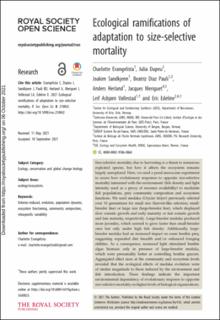| dc.contributor.author | Evangelista, Charlotte | |
| dc.contributor.author | Dupeu, Julia | |
| dc.contributor.author | Sandkjenn, Joakim | |
| dc.contributor.author | Pauli, Beatriz Diaz | |
| dc.contributor.author | Herland, Anders | |
| dc.contributor.author | Meriguet, Jacques | |
| dc.contributor.author | Vøllestad, Leif Asbjørn | |
| dc.contributor.author | Edeline, Eric | |
| dc.date.accessioned | 2022-01-26T13:38:20Z | |
| dc.date.available | 2022-01-26T13:38:20Z | |
| dc.date.created | 2021-10-08T09:12:30Z | |
| dc.date.issued | 2021 | |
| dc.identifier.issn | 2054-5703 | |
| dc.identifier.uri | https://hdl.handle.net/11250/2839487 | |
| dc.description.abstract | Size-selective mortality due to harvesting is a threat to numerous exploited species, but how it affects the ecosystem remains largely unexplored. Here, we used a pond mesocosm experiment to assess how evolutionary responses to opposite size-selective mortality interacted with the environment (fish density and light intensity used as a proxy of resource availability) to modulate fish populations, prey community composition and ecosystem functions. We used medaka (Oryzias latipes) previously selected over 10 generations for small size (harvest-like selection; small-breeder line) or large size (large-breeder line), which displayed slow somatic growth and early maturity or fast somatic growth and late maturity, respectively. Large-breeder medaka produced more juveniles, which seemed to grow faster than small-breeder ones but only under high fish density. Additionally, large-breeder medaka had an increased impact on some benthic prey, suggesting expanded diet breadth and/or enhanced foraging abilities. As a consequence, increased light stimulated benthic algae biomass only in presence of large-breeder medaka, which were presumably better at controlling benthic grazers. Aggregated effect sizes at the community and ecosystem levels revealed that the ecological effects of medaka evolution were of similar magnitude to those induced by the environment and fish introduction. These findings indicate the important environmental dependency of evolutionary response to opposite size-selective mortality on higher levels of biological organizations. | en_US |
| dc.language.iso | eng | en_US |
| dc.publisher | The Royal Society | en_US |
| dc.rights | Navngivelse 4.0 Internasjonal | * |
| dc.rights.uri | http://creativecommons.org/licenses/by/4.0/deed.no | * |
| dc.title | Ecological ramifications of adaptation to size-selective mortality | en_US |
| dc.type | Journal article | en_US |
| dc.type | Peer reviewed | en_US |
| dc.description.version | publishedVersion | en_US |
| dc.rights.holder | Copyright 2021 The Authors | en_US |
| dc.source.articlenumber | 210842 | en_US |
| cristin.ispublished | true | |
| cristin.fulltext | original | |
| cristin.qualitycode | 1 | |
| dc.identifier.doi | 10.1098/rsos.210842 | |
| dc.identifier.cristin | 1944348 | |
| dc.source.journal | Royal Society Open Science | en_US |
| dc.relation.project | Norges forskningsråd: 275125 | en_US |
| dc.relation.project | Norges forskningsråd: 268218 | en_US |
| dc.relation.project | Norges forskningsråd: 251307 | en_US |
| dc.relation.project | Norges forskningsråd: 255601 | en_US |
| dc.relation.project | Norges forskningsråd: 272354 | en_US |
| dc.identifier.citation | Royal Society Open Science. 2021, 8 (10), 210842. | en_US |
| dc.source.volume | 8 | en_US |
| dc.source.issue | 10 | en_US |

